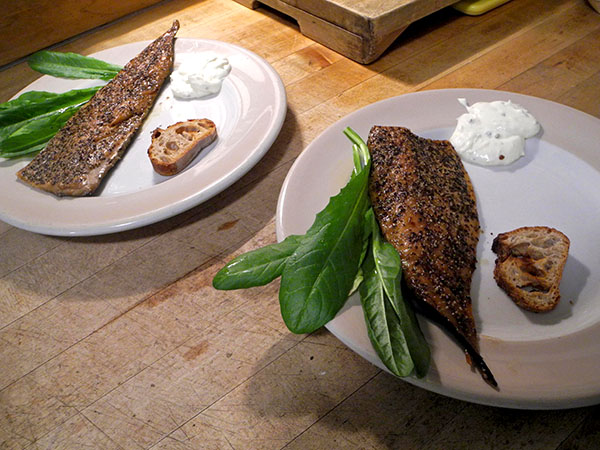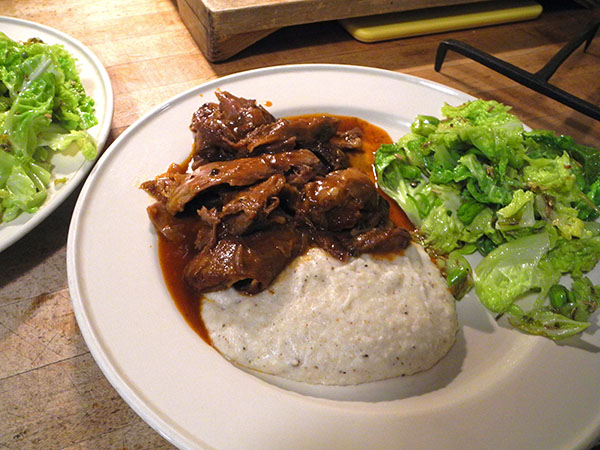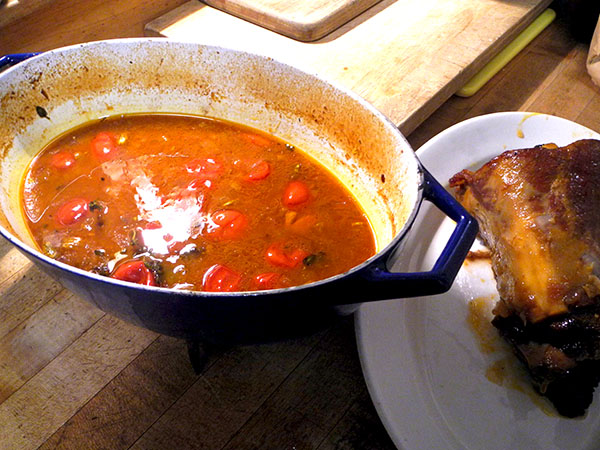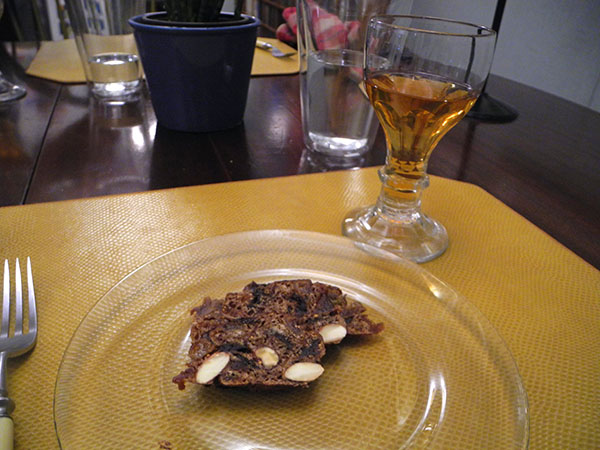
While I was growing up, New Year’s Day was a pretty grand occasion at our home: There would be guests, always interesting family friends, but almost never relatives. We were family outliers in Detroit, hundreds of miles from eastern Wisconsin where most of the tribes of both our parents were still based, their ancestors having cleared the old-growth forests and settled down on large dairy farms over a hundred years before.
Our Christmas tree was always pushed out of the house 2 days before (having arrived only a couple days before Christmas), an important moment which may have been a disappointment but it was also a relief, even to the young ones. In the afternoon, as the light outside dimmed, there would a special meal, with all the best china and glass, and tall candles(!), arranged on the extended dining table around a green centerpiece now liberated from the attributes of the immediately preceding holiday. There would be a roast of some kind, usually roast beef or ham, as well as all of the accompaniments traditional in the 1940s and 50s. There would be a fire burning in the living room, both weather and Mother permitting (no romantic, she thought wood fires were just dirty).
The rooms would look nothing like ours did yesterday, and not merely because we needed fewer chairs at the table: Mackerel was unknown on Haverhill Road, and I don’t think we ever had lamb in all the time I was living at home. I know we never had goat, and even polenta wasn’t part of the heritage of our beautiful Italian-American neighbors and friends, whose families had likely come from areas south of Tuscany.
We were Midwestern American locals, and even the foods we enjoyed, because of the modesty of that era and class, might have been surprisingly local. Today, in a much more ‘connected’ world we have to make a conscious effort to be locavores.
Yesterday’s first course was almost as local as almost everything else that was a part of this meal, the fish and its processing being identified with Maine, a place and an idea to which I feel close.
- six ounces of Ducktrap River of Maine‘s ‘smoked peppered’ wild mackerel fillets from Chelsea”s Westside Market, served with dollops of local Ronnybrook Farms crème fraîche, stirred with grated horseradish root from Norwich Meadows Farm and drops of organic Whole Foods Market lemon, sea salt and freshly-ground black pepper
- a few live hydroponic dandelion greens from Two Guys from Ridgefield, dressed with a good Sicilian olive oil, from from Agricento, Azienda Agricola Mandranova (using exclusively Nocellara olives), Maldon salt, and freshly-ground black pepper
- toasts from a several-days-old buckwheat baguette from Runner & Stone Bakery
- the wine was a German (Mosel) white, Weingut Axel Pauly Trinkfluss 2014

The second course was more tricky, and the timing the completion of its 3 elements was not made easy by having the polenta milk/water mix boil over onto the surface of the range early in the polenta process, putting out the pilot light (at a moment when each of the 4 burners was covered with a pot that had to be removed for it to be re-lit), but I thought it was something of a triumph in the end.
It was my first goat neck, so I looked for recipes. Goat is little different from lamb in most respects, except perhaps for its normally smaller size or its reputed stringiness, so when I found this one, which addressed both, I jumped on it, and ended up working pretty closely with it.

The sauce produced by the braised goat may have been the best I had ever been able to ‘shepherd’ inside my kitchen, and yet all I did was boil it down for a while – while stirring the corn flour mix – after straining out the vegetables that had flavored it; because of the gelatin in this cut of meat, it needed no outside thickening agent.
- one 26-ounce goat neck purchased from Tony at the Consider Bardwell stand in the Union Square Greenmarket, seared on all sides over a medium-to-high flame until brown in 2 tablespoons of olive oil inside an oval enameled cast iron pot (with a cover to fit), removed from the pan and set aside, the heat reduced to medium and one chopped sweet yellow onion from Norwich Meadows Farm; a few ounces of a celery root, chopped, also from Norwich Meadows Farm; and one huge Rocambole garlic clove from Keith’s Farm added and cooked until colored, one branch of thyme from Stokes Farm and several interesting spices (1/2 tsp each of smoked piquante Spanish paprika, freshly-ground cumin, cinnamon, and coriander, plus a little less ground cardamom), cooked for 3 minutes, followed by over half a cup apple cider vinegar and a quarter of a cup of turbinado sugar, everything cooked until the liquid was reduced by half, 8 ounces of canned tiny Muti plum tomatoes with their juices, and a teaspoon of sea salt, brought to a boil, topped with the lamb neck, water added until the lamb neck was a little more than half covered, the pot lid placed on top and the whole moved to a preheated slow-to-moderate* (300º) oven the oven and cook for approximately 2 hours, maybe a little longer, or until totally tender, the meat almost (or actually) falling from the bones, the pot removed from the oven, the the neck removed from the pot and allowed to cool until it could be handled enough to pick the meat from the bones, then kept warm, while the cooking liquid with the vegetables and seasonings was passed through a strainer, the solids discarded, and the remaining liquid reduced until somewhat thickened (as they say, “able to coat a spoon”), the picked goat meat placed in the sauce and served
*I love to see the use of traditional measures of oven heat surviving beyond the age of solid fuel cookers; there’s also the holding-one’s-arm-in-the-oven-until-it-becomes-intolerable tip (if you can count to thirty it’s not hot enough for bread)
- coarsely-ground Iroquois White Corn Project white corn flour (hulled, ground, & roasted and hand crafted in Victor, New York as a program of the friends of Ganondagan, from the Greenmarket Regional Grains Project stall in the Union Square Greenmarket) cooked with water and whole milk (in a proportion of 3 to 1), finished with several tablespoons of several (4?) tablespoons of Organic Valley ‘Cultured Pasture Butter’, seasoned with sea salt
- the white and lighter green parts of a Japanese scallion from Norwich Meadows Farm, sliced, heated along with a tablespoon of fennel seed in one tablespoon of butter inside a small, heavy tin-lined copper pot until the scallion had softened and the fennel become pungent, then set aside while another tablespoon of butter, or a little more, was melted inside a larger heavy tin-lined copper pot and one 8-ounce Napa cabbage, also from Norwich Meadows Farm, roughly chopped, was added and stirred until wilted, after which the reserved scallion-fennel mixture, some sea salt, and a little freshly-ground black pepper were added, and the cabbage stirred some more, finished by tossing in the green tops of the scallions, chopped
- the wine with the main course was a rally great California (Napa) red, ‘Declaration’ 1849 Wine Company Napa Valley Cabernet Sauvignon 2014, the generous gift from an artist acquaintance, Saber
We’re not ‘sweet-toothed’, so ‘treats’ usually last weeks in our apartment. I had been very excited about picking up what is essentially a German fruit cake in the Greenmarket a number of days before Christmas, but we hadn’t been interested in a sweet course since. We were being very well entertained with good holiday savories. Last night might have been no exception, but as it was probably the last of the winter holidays, we decided to finally pay our little Hutselbrot the homage it had awaited.

- thin slices of a small (150g) Runner & Stone Hutselbrot (local organic all-purpose flour, almond paste, organic cane sugar, local butter, local eggs, oranges, 70% chocolate) from their stand in the Union Square Greenmarket
- the wine was a Portuguese (Porto) port, Porto Dalva 20 Years Old Dry White Port
- the music throughout the meal was a gorgeous brand-new recording of a newly-assembled pastiche representing Vivaldi’s 1726 melodramma eroico pastorale, ‘Dorilla in Tempe’, Diego Fasolis conductiing I Barrochisti (additional information on the piece here)
[most of the pictures above were taken while the food was still in the kitchen, since there isn’t enough light in the dining gallery for well-focused images]